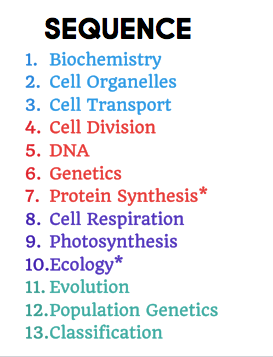
Biology Scope and Sequence
Whether you’ve been teaching biology for zero years or a zillion years, it’s never a bad idea to have a scope and sequence. This is essentially a document that helps map out your year to avoid any scrambling at the end (we’ve all been there one way or another).
One thing to consider when creating your scope and sequence (or using mine… more on that in a bit…) is that it’s made for you to feel less rushed and more relaxed… so tell yourself at the beginning of the year: “this isn’t written in stone!”. IF you go over by one or two days for a particular unit– no sweat! Just give yourself a nice buffer at the end of the school year to help cushion your course.
If you’re a new teacher, or you’ve got some years under your belt but you’re always on the lookout for some ideas and inspiration, I’ve compiled 3 separate scopes and sequences for your class, depending on your standards: traditional biology, NGSS high school, and NGSS middle school- AND– I’ve made a video to help you along! Watch the video if you need some guidance and download the items below!
Don’t have time to watch the video? No problem. Here is the sequence I teach:
The 4 colors represent the way I chunk the material. Don’t teach population genetics? No problem. Just keep evolution and classification together. Do you teach plant and animal interactions? That would go with ecology.
Why the *asterisks next to protein synthesis and ecology? I feel those have more flexibility. You can stick protein synthesis before genetics right after DNA. Ecology can fit in mostly anywhere! I would sometimes like to save ecology for the end of the school year when it’s warmer and we can explore outside.
This is a general guide that you might need to tailor to your classroom- especially if it doesn’t look quite like mine! Editable versions found below!
However, if you stick to NGSS standards like Massachusetts, then you can most likely use as is, unless of course you need to play with the number of days included in the scope.
Traditional Biology Scope and Sequence
High School NGSS- HS LS Scope and Sequence
Middle School NGSS- MS LS Scope and Sequence

